THIS BOOKLET HAS BEEN PREPARED IN
GRATEFUL REMEMBRANCE OF GOD’S BLESSING
FOR THE
Diamond Jubilee
Of
TRINITY LUTHERAN CHURCH
Deer Creek Township
Fort Dodge, Iowa
1890-1965
This booklet was donated by Tyler Rasmussen.
It was transcribed by Sharon Elijah
and formated by Lynn McCleary, February 18, 2021
Page 2
A MESSAGE FROM THE PASTOR
It is only with humble gratitude to Gad that we come to an event so significant as the 75th anniversary of our congregation. For some of our members this event recalls 75 years of spiritual blessings in this congregation. Others, while not here at the time of its founding can nevertheless recall a life time of blessing through Word and Sacrament in this congregation. Certainly these must be grateful people as they realize that through this organization, composed of sinful human beings, God has been present in Word and Sacrament to give to them the assurance of forgiveness, and point them to life everlasting with Him.
For many in this congregation, however, the association with this church has been much more recent. There are the children who are just beginning to enjoy a personal acquaintance with the Heavenly Friend, the young people who not so many years ago stood before this Altar and pledged their loyalty to their Lord, and the adults to whom the congregation today looks for leadership. Regardless of how long we have been members of this congregation we are all part of an assembly that recognizes and worships a common God, that professes a common faith in Jesus Christ as Savior and Lord, and that is joined together in a close union by this one faith. We are indeed “Many members, yet one body”, as the apostle puts it.
The observance of this anniversary can only serve to strengthen the feeling of oneness among us. As the history of this congregation, written in these pages, unfolds before us, and points to an unbroken line of faithful Pastors and Teachers, as well as the tireless and often thankless efforts of the Laymen and women, certainly it reveals to us how, under God, His faithful have worked together here in carrying out their God-given mission.
As we, the members of Trinity today, continue to write the record which shall be recorded in the future, may we also, recognizing our oneness in Christ, work together under Our God, so that Trinity may continue to fulfill its mission. The future, of course, is always uncertain, but out of the past, clear and sure and promising, comes the Voice of the Master, sounding as it has always sounded through the long centuries of the Christian era, reassuring us now, as it reassured the founding Fathers of this church: “Lo I am with you always, even unto the end of the world”. This is the voice we must follow!
Page 3
The History of Trinity Congregation
The historical beginning of Trinity Evangelical Lutheran Church in Deer Creek township, Webster County, Iowa, leads us back to the early history of St. Paul’s Lutheran church in Fort Dodge. The earliest dates reach back to the pioneer days of Webster County, when the country side was sparsely settled. They were the days of rugged development, when an ambitious people, braving the hardships, the toil and labor, the trials and troubles accompanying the pioneer days, triumphantly laid the foundation of our agricultural enterprise.
Among these pioneers and organizers of Trinity congregation we find the familiar names of: Behrens, Hoyer, Schulze, Holst, Moench, Licht, Voigts, and others. The early pioneer Lutheran families who had immigrated from Germany and settled in Fort Dodge and vicinity were for some time as sheep without a shepherd. Great was the joy when the first Luteran pastor appeared in Fort Dodge and served the Lutherans in this vicinity. He was the Reverend Dr. Frederick Flickenscher, who walked from Boonsboro (now Boone) and conducted the first Lutheran service in Fort Dodge on January 20, 1861, in the home of Leonard Fessel. On December 20, 1863, St. Paul’s Ev. Lutheran congregation was organized. The congregation grew rapidly, gathering in the Lutheran immigrants from far and wide. In 1877, Lutheran families living in Colfax township petitioned the congregation for permission to withdraw for the purpose of organizing their own church. The petition was granted, and the first daughter of St. Paul’s, St. John’s congregation of Colfax township, came into being.
It was during the pastorate of J. L. Craemer that St. Paul’s congregation took another progressive step and passed the resolution to provide schooling for the children of members living greater distance from the city. Student August Meyer was employed and who taught in Deer Creek township from 1878-1880. Our early fathers showed great love and stood ready to bring great sacrifices for the purpose of Christian education, for during these years private homes were opened unto the children and Teacher August Meyer. School was conducted in the Wm. Hoyer home, and in the Henry Behrens home, which is still standing today, north of our present teacherage.
The parents recognized the great advantages of Christian education, and so in 1880 erected, what became the first schoolhouse of Trinity congregation. It was small, 16x20, humble and modest in beginning. Altho modest in beginning it required loving sacrifices. Henry Behrens donated the acre of land whereon the first school house was built. These are the members who built the schoolhouse: Wm. Hoyer, Wm. Holst, Henry Hoyer, Henry Behrens, M. Rasmann, Henry Reck, Henry Finck, and Wm. Schulze, who was appointed as the first school board.
In 1881 the members living in Deer Creek township petitioned St. Paul’s congregation for permission to organize their own school district. The petition was granted, and H. Engholm was called as first resident teacher of Deer Creek Township School.
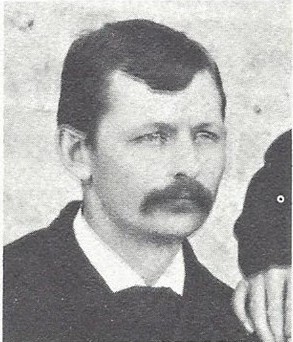
H. Engholm
The first resident teacher of
Deer Creek Township School
|
Teacher Engholm made his home with Henry Behrens. Then in 1882 the members provided a home for the teacher. The teacherage was erected near the schoolhouse. After the congregation was organized this house served as the parsonage until the present parsonage was built in 1901. The year 1883 marks another sign of progress and again demonstrates the spirit of Christian sacrifice. In that year Wm. Hoyer donated the land for a cemetery. A few years later the members graced this plot of ground with cedars, and expressed the resurrection hope within them by planting them as to form a cross.
Page 4
In the spring of 1886 Teacher Engholm of Deer Creek School resigned, and in the fall of that year was succeeded by Teacher L. Schlacht. In September 1889 Teacher Schlacht resigned. Following the resignation of Teacher Schlacht, the Deer Creek District decided to establish an independent parish, and call a pastor. Because of inclement weather, rain, snow, and also the great distance, the members of Deer Creek were unable to attend services regularly. Love for God’s Word, therefore, led 15 members to petition the mother congregations for permission to withdraw. The request was granted, and the second daughter of St. Paul’s Lutheran Church, Trinity Congregation of Deer Creek Township, was organized.
The organization was effected on the 2nd day of February, 1890. Fifteen members signed the constitution. The fifteen names appearing with the original signatures under the original constitution are as follows: Henry Behrens, William Hoyer, William Schulze, Henry Fink, William Holst, Henry Hoyer, William Meyer, Henry Behrens, Henry Moench, Henry H. Licht, Ernest Moench, Henry J. Licht, William Moench, Fredrich Voigts, and William Kiehn. The first trustees of the congregation were: William Schulze, William Meyer, and William Holst; the first treasurer: William Holst; and the first secretary; William Meyer.
1st Row: Henry Behrens, Sr., William Hoyer, William Schulze, Henry Fink, William Holst
2nd Row: Henry Hoyer, William Meyer, Henry Behrens Jr., Henry Moench, Henry H. Licht
3rd Row: Ernest Moench, Henry J. Licht, William Moench, Fredrich Voigts, William Kiehn
Page 5
Having organized into a congregation, the little flock soon desired its own house of worship. In the congregational meeting held January 1891, plans of the new church were adopted. The dimensions of the building were to be 30x44x16, and in addition the altar niche, the vestry, and the church spire 65 feet in height. The contract was let to Gottlob Proeschold of Fort Dodge.
During the succeeding months the members again showed a wonderful spirit of cooperation, for it was thru their untiring efforts against tremendous hardships that the church became a reality. All the building materials had to be hauled by means of a horse and wagon. Stones for the foundation were dragged from the neighboring fields, the creeks, and river. All hands worked together in laying a firm foundation for the building of which their children were proud for many years to come. The little flock built large, looking beyond the immediate future, and invisioning a future when their children and grandchildren would fill the church. For sixty-three years this edifice stood as a monument to our father’s keen vision, undaunted courage and faith in Him, who is the builder of the church. This first church building served the needs of the congregation until 1954, when it was torn down and replaced by the present structure.
Early in September the new church building was completed, and thus September 6, 1891 was a day of great rejoicing for Trinity congregation. The cause for joy was two-fold. For not only was it the day of dedication, but it was also the day when Trinity’s first resident pastor, the Reverend August Hemann, was inducted into office.
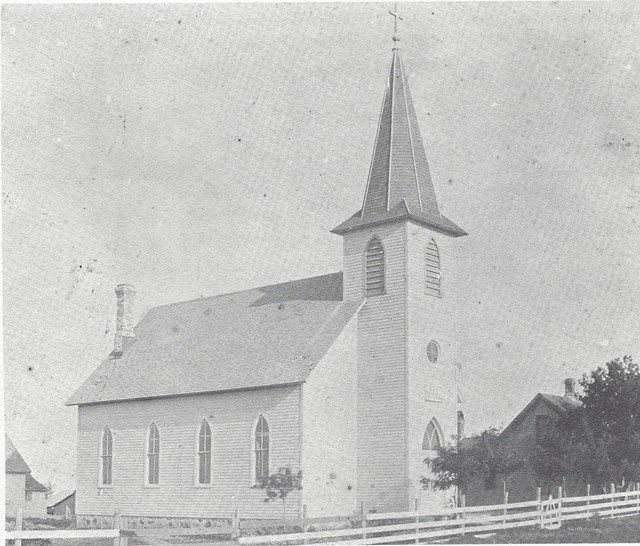
Trinity’s first school, church and parsonage |
Page 6

Rev. August Hemann |
During the pastorate of August Hemann the congregation enlarged the church ground, purchasing half an acre of land from Henry Behrens for thirty dollars. The Rev. August Hemann, in addition to the pastoral duties, also had charge of the Christian Day School, as did his successors till the year 1941.
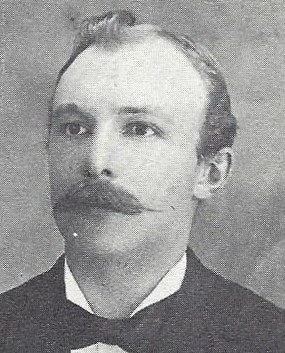
Rev. Schaller |
In the year 1895 the congregation lost its first pastor, who accepted a call, and the Rev. Paul Schaller was called. The Rev. Schaller served the congregation faithfully for eight years. During his pastorate the church grounds were once more enlarged, the congregation purchasing half an acre of land from T. Downing for fifty dollars. In 1899 the first school house was enlarged from 16x20 to 20x32 feet so as to enable the growing congregation to train its children properly. In 1901 the congregation sold its first parsonage, which was replaced by its present spacious nine room house.
In the year 1903 the Rev. Paul Schaller accepted a call to Beloit, Wisconsin and the Rev. Martin Brueggemann was called from Elma, Iowa, as his successor.
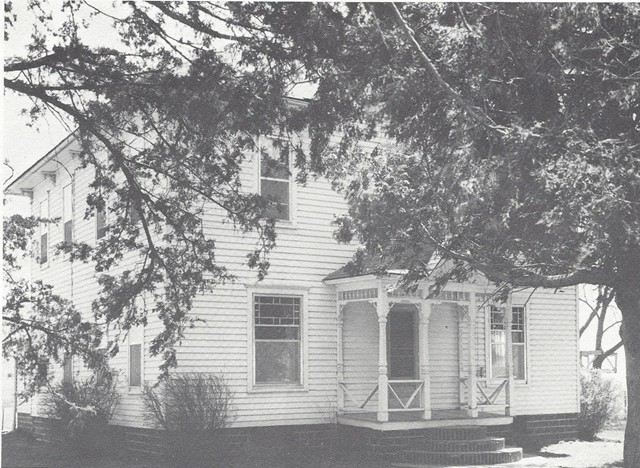
Present Parsonage |
Page 7
Scarcely had four years elapsed when the Rev. Martin Brueggemann accepted a call to Memphis, Tennessee. The congregation then sent a call to the Rev. Schroth in Hanover, Wisconsin. Upon the return of the call, the congregation then called the Rev. C. H. Seltz, who in 1907 became the successor of the Rev. Martin Brueggemann.
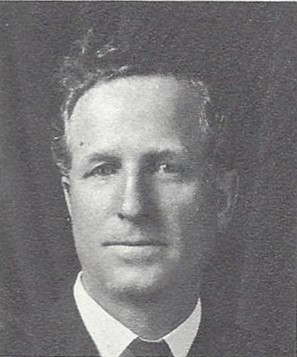
Rev. C. H. seltz
|
During the pastorate of C. H. Seltz the congregation showed much activity. In 1908 a new heating plant was installed in the parsonage. In 1909 the congregation installed a bell to ring out the glory of God and to call the weary pilgrims to prayer and worship. This bell is still in use today in the present church.
In 1911 an organ was purchased. The following year the church was renovated and special Thanksgiving services were arranged with the Rev. Th. Stephan preaching the sermon. In 1913 the congregation collected sufficient funds to furnish a room at River Forest Teachers college. In 1915 the congregation celebrated the 25th anniversary of the dedication of the church. In 1917 financial aid was given in the erection of the Lutheran hospital at Hampton, Iowa. In 1919 the English language was employed in the parochial school. Having completed almost 50 years in the office of the ministry, the Rev. C. H. Seltz resigned from active duty, and in the year 1939 he entered the heavenly Jerusalem.
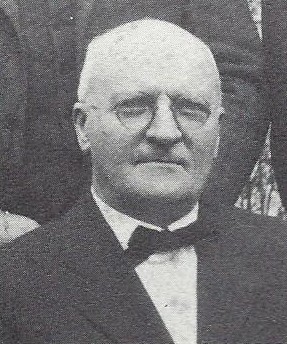
Rev. Martin Zagel
|
His successor in office was the Reverend Martin Zagel, who accepted the call in April, 1920. During his pastorate financial assistance was given to the erection of Concordia Seminary, St. Louis, Mo. In 1925, March 8, the growing congregation built its third school house, which was dedicated September 20th.
After fifteen years of diligent labor, the Rev. Martin Zagel resigned from office in August of 1935. The Rev. Joel E. Ross served as vacancy pastor.
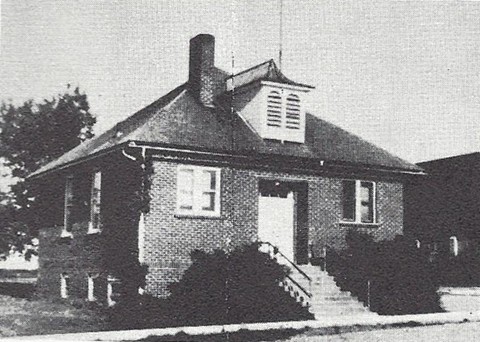
Old Trinity School
1925-1959 |
Page 8
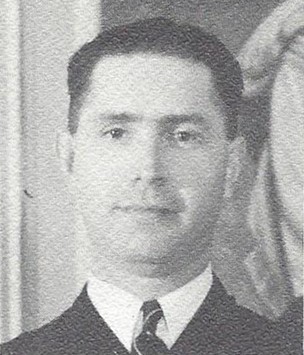
Rev. W. K. Kautz
|
In December, 1935, the Rev. W. K. Kautz, who was serving in Canada, accepted the call to Trinity congregation. In 1938 the church was moved fifty feet from the roadway. A full basement and new heating plant was installed under the church. A mother’s room was added and the vestibule was enlarged. The building was renovated and rededicated Nov. 27, 1938, the festive speakers being: The Rev. E. J. Otto, and the Rev. L. Wittenburg. In 1940 a new heating plant was installed in the schoolhouse. In the following year the Rev. W. H. Kautz accepted a call to Adair, Iowa.
Teacher Richard Miessler was employed to complete the two remaining months of the school term.
Once again the Rev. Joel E. Ross served as vacancy pastor. During this time the church property was much enhanced by the landscaping the grounds, planting trees, graveling a parking lot, and replacing the old barn with a modern garage.
Also an important change took place in the Christian Day School. Realizing that the increased duties of a growing congregation demanded the full time of the pastor, it was decided to relieve the minister of the work in the school, and engage instructors.
On May 25, 1941, after a brief vacancy, the Reverend A. F. Boehnke was installed, who served the congregation faithfully until 1950 when he accepted a call to Pilgrim Lutheran Church, Lake City, Iowa. During his 9 years at Trinity, there was much activity. The congregation celebrated it’s 50th anniversary in the fall of 1941, the observance being late because of change in pastors. The date of the anniversary observance was September 14, 1941. Reverend Martin Seltz preached for the morning service, and Reverend Herman Zagel preached for the afternoon service. Both of these men were the sons of former pastors. For this occasion the congregation purchased a new electronic organ.
The following years were trying times for the nation, and also for the church, because our nation was at war. The minutes of the congregation contain statements about the difficulty of getting building material for repairs, a decision to drop mid-week Lenten services because of existing conditions, plans for a service of thanksgiving within two hours after the peace is signed, and many others. Among those appearing on the list of men in the armed services during World War II are these names: Glenn Behrens, Paul Meyer, Emmett Niemeyer, Leonard Rosendahl, Ray Gochee, Richard Miessler, Richard Trost, John A. Schultz, Robert Hoyer, Budd Gochee, Harold Licht, Donald Behrens, Roland Wendelken, Waldo Bargsten, Edgar Licht, L. S. Kozel, Alvin Holst, and Richard N. Smith. All but one of these, Emmett Niemeyer, returned home safely, and many of them are leaders in the congregation today.
Page 9
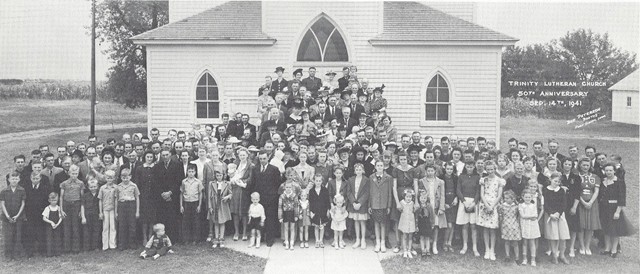
The Congregation in 1941 |
Page 10
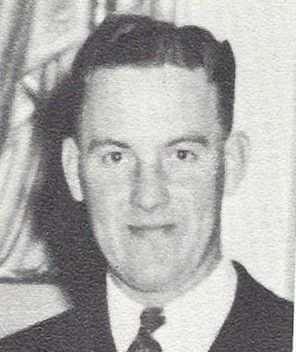
Teacher Melvin Lillich |
Because Teacher Miessler was among those who had entered the armed services, another teacher was needed for our school. Teacher Melvin Lillich was engaged in time for the fall school term in 1942.
The year 1942 marked the beginning of the Sunday School in Trinity Congregation. Because the congregation as aware of its responsibilities in regard to Christian Education, especially to the young, they saw the necessity of opening a Sunday School in addition to the Christian Day School, which the congregation had maintained since its beginning. This agency continues to teach God’s word to both young and old today. In the year 1949 the adult Bible Class was added to the Sunday School. Four of the original teachers are still serving on the Sunday School staff today. Special recognition should be given to the following who have served many years on the staff of the Sunday School: Mrs. Emil Schulze-23 years; Victor Niemeyr-23 years; Mrs. Victor Niemeyer-23 years; Werner Schultz-22 years; Herbert Gehring-19 years; Mrs. Lawrence Schultz-19 years; Mrs. William Licht-18 years; Mrs. Ewald Schulze-17 years; Carl Hoyer-16 years.

Sunday School Teachers: Left to right: Victor Niemeyer, Robert Hoyer, Mrs. Victor Niemeyer, Herbert Gehring, Mrs. Herman Burger, Mrs. John Schultz, Mrs. Werner Bargsten, Werner Schultze, Mrs. Lawrence Schulze, Mrs. Ewald Schulze, Pastor Brandt, Mrs. Brandt, Mrs. Emil Schulze. |
These were also years of many changes in the congregation. An English Constitution was adopted in 1942. (The German services had been discontinued since 1939) 1943 saw an end of the old fashioned Mission Festivals in Wm. Licht’s Grove. The two services, however, were continued for many more years.
Page 11
In 1943 ground was purchased and a house was moved on to it, to serve as the first teacherage. This home was later replaced by the present teacherage. In this year the congregation also installed stained glass windows in the church.
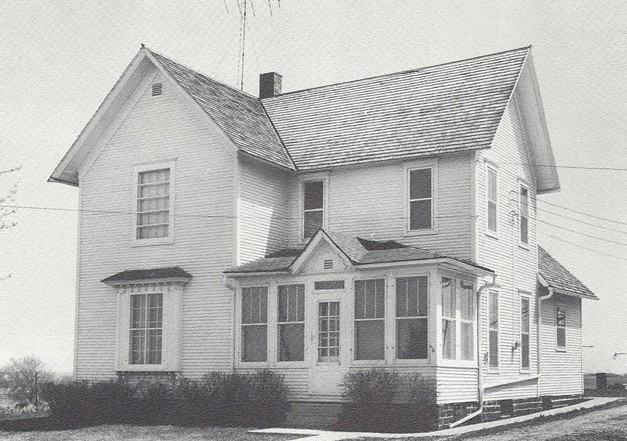
Present Teacherage |
In 1945, Teacher Melvin Pohl accepted a call to Zion Lutheran in Vernon, Texas. Teacher Einspahr accepted a call and served as teacher for the next two years. During his time the school library was established, and kindergarten classes were initiated in our school. Following Teacher Einspahr, Teacher E. Weerts accepted the call of the congregation, and began his duties in the fall of 1947. He served the congregation until 1954. In 1949 Trinity’s expanding school had reached an enrollment of over 50, and the congregation once more voted in favor of Christian Education, and decided to employ the second teacher in the lower grades. The class room for the lower grades had to be in the basement of the old school. Eleanor Gehring was employed as the lower grade teacher.

Left to right: Teacher Pohl, Teacher Einspahr and Teacher Weerts |
Page 12
1st Row: Miss Gehring 49-55; Miss Lieske, 55-56, Mrs. Berner 56-57; Mrs. Knopf 57-59
2nd Row: Miss Lavonne Carlson 59-61; Mrs. William Gardner 61-62; Miss Jacquelyn Tinkey 62-64; Mrs. Ronald Udy 64-
On September 3, 1950, Rev. Arnold Boehnke, after having returned six different calls, asked for a release in order to accept a call to Pilgrim Lutheran congregation at Lake City, Iowa. For 9 years he had served the congregation, and more than once the members of Trinity congregation expressed their appreciation for his services, such as making the parsonage modern and more livable, purchasing a new car for him in 1948, and many others. The Lord willing, the Rev. Boehnke will serve as the speaker for the anniversary services.
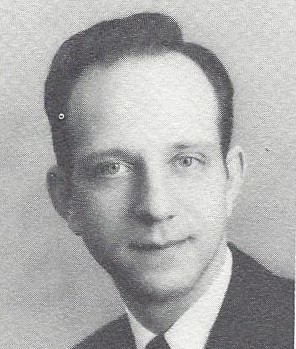
Rev. L. Reimann |
Rev. L. Reimann accepted the call of Trinity congregation and was installed on January 28, 1951. He served the congregation until 1953 when he accepted the call to Bethel congregation in Lawton, Iowa. In 1951 the present teacherage was purchased, and moved to its present location to replace the old teacherage.
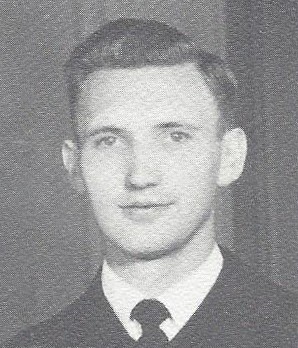
Rev. Paul Weber |
On August 30, 1953, Rev. Paul Weber, having accepted the call of the congregation was installed as their new pastor. Pastor Weber served the congregation until 1957. During his ministry here the congregation built the present church building.
Page 13
In October of 1953 because the old church building needed repair, and no longer adequately served the needs of the congregation, the congregation decided once more to go forward, trusting in the Lord. They voted to tear down the old church, and build a new one. Walter Schulze, Alvin Behrens, Albert Licht, William Meyer, and Lawrence Schulze were elected to the building committee. In March of the following year, the congregation began holding its services in the town hall in Badger, and the work of tearing down the old church began. The members of the congregation worked together hard and long, both in tearing down the old building and in erecting the new. Much labor was donated, and many hours spent to make the present church a reality, and at the same time to keep the cost within reach of the congregation. The altar and pulpit were sent to a congregation in Elmdale, Kansas. The materials from the old building were sold, except for the bell which was to call the worshippers into the new church. The second Sunday in June, 1954 marked a milestone in the building project when the congregation gathered for the cornerstone laying.
After more than a full year of working together and sacrifice on the part of the members of Trinity congregation, the building was completed, and dedicated to the Glory of God on May 8, 1955. The speakers for the two dedication services were Rev. Ad. Schwidder of Fort Dodge, and the Rev. Prof. George W. Hoyer of St. Louis, Missouri.

The New Church |
Page 14
In July of 1954, Teacher Weerts accepted a call to St. Paul’s congregation in Lakefield, Minnesota. Since the congregation was unable to get another teacher before the next school term, Pastor Weber taught for a few weeks until on September 19 of that year, the congregation employed Teacher Orville Ziegel. Teacher Ziegel served the congregation for 10 school terms. In 1963, after having completed his studies for his degree, Teacher Ziegel was given a call, and installed as a called teacher.

Teacher Orville Ziegel |
In 1957, the Rev. Paul Weber accepted a call to St. Paul’s congregation in Woodland, Indiana, and was given a peaceful release in a special meeting on March 17. The congregation, decided to apply for a candidate, and through the board of assignments of Synod, their call was given to Rev. Glenn Lashway. Pastor Lashway was installed that same year, and served the congregation until May of 1961 when he accepted a call to Trinity congregation in Rock Ledge, Florida.
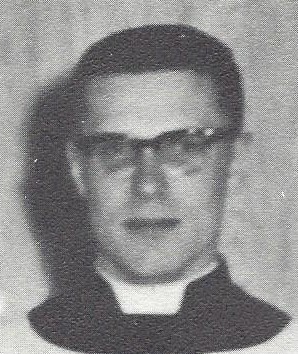
Rev. Glenn Lashway |
After the completion and dedication of the new church in 1955, the thoughts of the congregation again turned to the needs of our school, and Christian Education. In the late forties, when the second room was added in the church basement, this was looked upon as a temporary situation. In the regular meeting in July, 1959, because of the crowded conditions in the school, the congregation again decided on a major building project. This was the second in five years. They voted to buy an additional acre of land, and to start building a new school immediately. At the beginning of the school term of that year, classes were held in the church basement until the new building was completed. Once more the members of Trinity congregation had voted in favor of Christian Education. The building committee was chosen: Harold Hett, Werner Bargstgen, Carl Hoyer, Edgar Licht and Werner Schultze. The following Sunday, Ground Breaking Ceremonies were held, and on August 9, the cornerstone was laid. When the children returned from their Christmas vacation in January of 1960, they could move into the new building. With a wonderful spirit of cooperation among the members, and many hours of donated labor by the members, the new building was soon completed. March 13, 1960, marked the dedication of the new school. The speaker for the occasion was the Rev. Martin Seltz, of Boone, Iowa, the District Secretary of Christian Education.
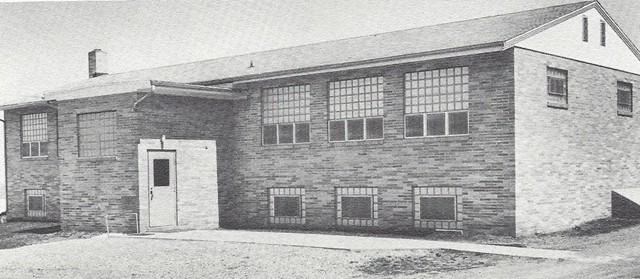
The New School |
Page 15
After Rev. Glenn Lashway, in 1960 had accepted a call to Florida, the Rev. M. H. Brandt, the present pastor accepted the call to Trinity congregation, and was installed on October 29, 1961. In the fall of 1961, the congregation held its first Harvest time Gift Day, to give the members of the congregation a special opportunity to express their thanks to the Lord for His blessing during the year. This has been continued in recent years. In the spring of 1962, the congregation conducted its first Vacation Bible School. In the spring of 1965 the congregation purchased a new Allen organ.
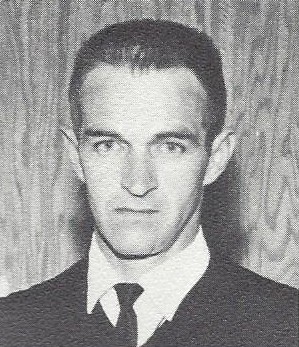
Rev. M. H. Brandt |
In 1963, after having returned three calls the summer before, Teacher Ziegel accepted a call to Concordia Lutheran Church in Fort Wayne, Indiana. He stayed until after the school term. The congregation then applied for a teacher candidate, and the call as given to Mr. Ronald Udy, the present teacher.
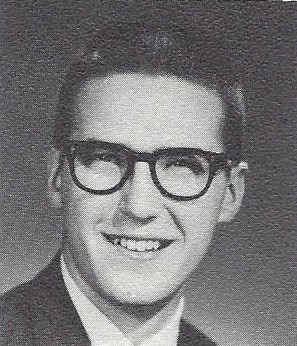
Mr. Ronald Udy |
The history of any congregation is the history of the preaching and the teaching of God’s Word, the history of the administration of the Sacraments and the history of people, as they respond to God’s love, and plan and work for the furtherance of His Kingdom on earth, and finally enter His Kingdom of Glory above.
By God’s grace ten of the members of the congregation at the time of its organization are still members today. Mrs. Emma Behrens, whose husband, Henry Behrens, Jr. was one of the original signers of the constitution when the congregation was organized is one of these members. Mrs. Behrens, now 94 years old is confined to her home.
Page 16
Nine of the baptized members of the original congregation are still members today. They are as follows: Front row: Mrs. Emma Schulze, Mrs. Martha Bargsten, Mrs. Anna Niemeyer, Mrs. Martha Schulze. Back row: Walter Trost, Mrs. Walter Trost, Henry Licht, Mrs. William Niemeyer, and William Niemeyer.
The first baptism recorded in the history of the congregation is Flora Augusta Hemann, baptized on March 6, 1892. Following this first infant, 688 others have been received into God’s Kingdom through the Sacrament of Baptism.
On March 26, 1893, the first class of 6 members had been instructed in the Word of God, and were confirmed in Trinity congregation. 427 members of Trinity congregation have renewed their baptismal vow through the right of confirmation in the history of the congregation. The largest class consisted of 12 members in 1961.
The first funeral service in the congregation was for Johann Heinkel on December 14, 1891. 127 times the congregation has gathered to seek comfort from God’s word when a member was called to the eternal rest.
In the history of the congregation there were 147 marriages performed. The first being for Wilhelm Moench, and Martha Voigts on October 29, 1891.
Altho modest in beginning, and always a small congregation, perhaps due to its rural location, Trinity congregation has always manifested a love for the Word of God. This is evident in the buildings, churches and schools they have erected, in the fact that they have always maintained a Christian Day School in their midst, and in all the Auxiliary organizations in the congregation which have the purpose of studying God’s Word, and helping the members to respond to that Word in a God pleasing way. The importance of the Word of God in the lives of the members of the congregation is also evident in the number of workers that Trinity has given to the church at large for the teaching and preaching ministry. Among the confirmands of Trinity congregation who have served or are serving the church are the following: Pastors: Martin Seltz, Herman Zagel, Robert Seltz, and Duane Hoyer. Teachers: Gordon Licht, Marcella Licht, Inez Licht, Ruth Schultze, Annette Bargsten, and Marlene Hoyer. Studying for the ministry at Concordia Seminary at St. Louis at the present time is: Roger Hett. Studying for the teaching ministry at Concordia Teachers College at Seward are: Denis Peters, Mary Hett, and Charlette Niemeyer.
Page 17
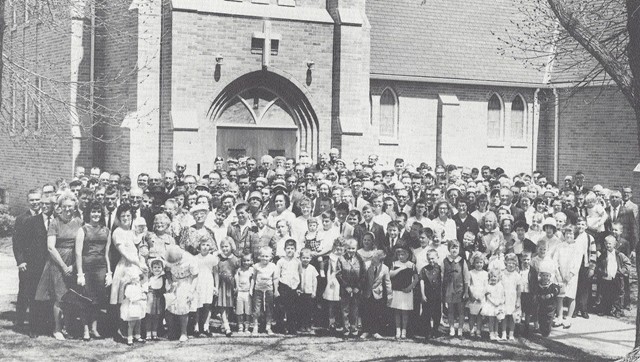
The Congregation Today |
At the present time Trinity Congregation has a membership of 64 voters, 240 communicants, and 357 souls. May Trinity Congregation continue progressing in the future. May its sole purpose be the salvation of immortal souls, and the Word of God its only guide for life, and may God continue to bless her.
Page 18
TRINITY LUTHERAN SCHOOL -
First Row: Left to right: LuAnn Licht, Darlene Hett, Joey Bargsten, Becky Brandt, Dawn Licht, Lanny Clough, Donna Seltz, Ruth Duis, David Hotz, and Lisa Brandt.
Second Row: Dana Hotz, Chris Brandt, Joel Schultz, Eddie Froisland, Bobby Hotz, Johnny Froisland, Diane Clough, Michelle Clapper, and Nancy Cuckie.
Third Row: Mark Licht, Debbie Burger, Susan Schultze, Linda Meier, Patty Stahl, Deanne Burger, Nancy Holst, Rose Duis.
Fourth Row: Bernice Schultze, Donnie Meier, Ricki Hotz, Nathan Brandt, Keith Clapper, Dennis Moench, David Hoyer.
Fifth Row: Ranae Licht, Beverly Habben, Mike Meier, Keith Clapper, Richard Hoyer, Mark Schultz, Dennis Clapper.
Sixth Row: Christine Seltz, Kathy Cuckie, Paula Meyer, Becky Schultze, Carol Holst, Jaci Meyer, Marian Bargsten, Marilyn Bargsten.
Last Row: Eugene Hett, Pastor Brandt, Bobby Meyer, Steven Hotz, Teacher Udy, Edwin Schultze, Mrs. Ronald Udy, Barbara Kastner.
Page 19

WOMEN’S LEAGUE |
The first organization of the Ladies of Trinity congregation was a Ladies Aid organized January 27, 1931. On October 7, 1936, another group of ladies organized a second group called Trinity Sewing Circle. The present organization was formed in 1944.
The present organization is a member of the Lutheran Women’s Missionary League, and also a member of the Lutheran Home Finding Society Auxiliary. On the picture taken after services on May 2, 1965 are:
Front Row: Left to right: Mrs. Ellen Schultze, Mrs. Albert Licht, Mrs. Weldon Hett-Secretary, Mrs. Lawrence Schulze – President, Mrs. Lilly Hoyer, Mrs. Edgar Licht, Mrs. Herman Burger, Mrs. Werner Bargsten, Mrs. Elmer Fuller, Mrs. Anna Niemeyer, Mrs. William Meyer.
Second Row: Mrs. H. Brandt, Mrs. Alvina Holst, Mrs. Howard Grebner, Mrs. Albert Schultze, Mrs. Harold Hett, Mrs. Alfred Holst, Mrs. William Licht, Mrs. Karl Stahl, Mrs. Alwin Behrens, Mrs. Herbert Gehring, Mrs. Emil Schulze, Mrs. Virlin Pagel.
Third Row: Mrs. Carl Hoyer, Mrs. Arthur Jacobs, Mrs. John Schultz, Mrs. Donald Seltz, Mrs. Paul Meyer, Mrs. Earl Meier, Mrs. Robert Hoyer, Mrs. Ewald Schulze, Mrs. Hilbert Licht, Mrs. Werner Schultze, Mrs. Donald Meyer, Mrs. Victor Niemeyer.

MEN’S CLUB |
The Men’s Club of the congregation was organized on February 29, 1952, and since its organization has been affiliated with the International Lutheran Laymen’s League. The first officers of the organization were: Walter Schulze, President; Bert Hoyer, Vice President; Membership Secretary, Robert Hoyer; Treasurer, Arthur Jacobs; Secretary, Werner Schulze. One of the major projects of the Men’s Club through the years has been to enlist roll call memberships in the International Laymen’s League. At the present time there are 108 roll call members.
First Row: Left to Right: Albert Schultze, Henry Froisland, Elmer Fuller, Carl Hoyer, Albert Michehl, Walter Schulze, John Schultz, Werner Schultze.
Second Row: Alfred Holst, Arthur Jacobs, Albert Licht, Lawrence Schulze, William Hotz, Herman Burger, Wilbert Niemeyer.
Third Row: Ewald Schulze, Fred Consier, Emil Schulze, Walter Licht, Hilbert Licht, Charles Scholl, Pastor Brandt.
Page 20
THE WALTHER LEAGUE was organized on July 5, 1934 as a young people’s society, and joined the International Walther League in March of 1941. The first officers were Paul Meyer, president; Carl Hoyer, vice president; Esther Bargsten (Moench), Secretary; and Laura Niemeyer (Hett), treasurer. All of these first officers of the Walther League are members of the congregation today, and three are parents of present Leaguers. The Walther League at the present time numbers 40 members. The pictures of the League were takes at its April meeting in 1965.
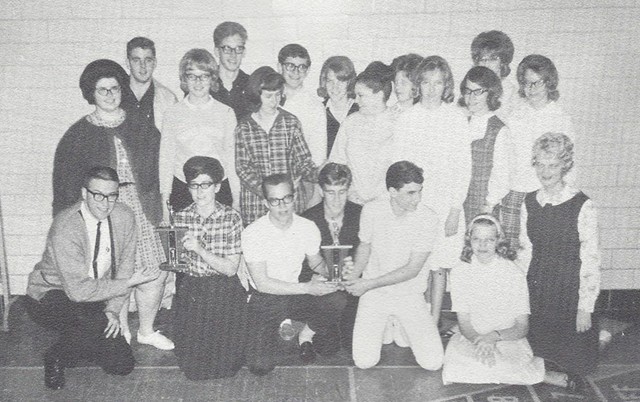
THE WALTHER LEAGUE |
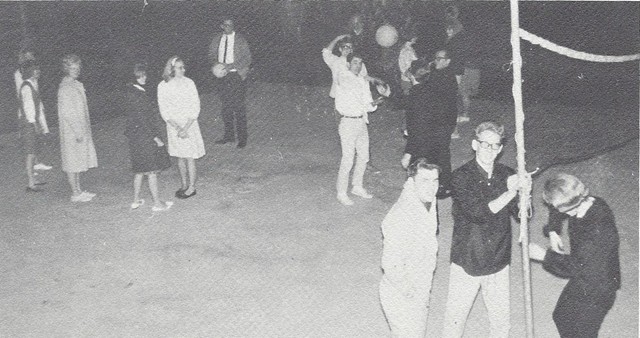
THE WALTHER LEAGUE
preparing for a game of Volley Ball |
Page 21
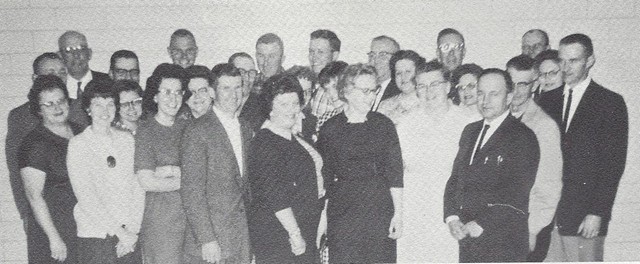
COUPLES CLUB
|
First Row: Left to right: Mrs. Ewald Schulze, Mrs. William Hotz, Mrs. Donald Seltz, Mrs. Herman Burger, Mrs. Elmer Fuller, Edgar Licht, Mrs. Edgar Licht, Mrs. Hilbert Licht, Mrs. Vernon Niemeyer, Mrs. Carl Hoyer, Mrs. Lawrence Schulze, Mrs. Martin Moench, Mrs. Victor Niemeyer, Carl Hoyer, Martin Moench, Mrs. Weldon Hett, Pastor Brandt.
Second Row: Left to right: Herman Burger, Ewald Schulze, William Hotz, Donald Seltz, Elmer Fuller, Hilbert Licht, Vernon Niemeyer, Lawrence Schulze, Victor Niemeyer, and Weldon Hett.
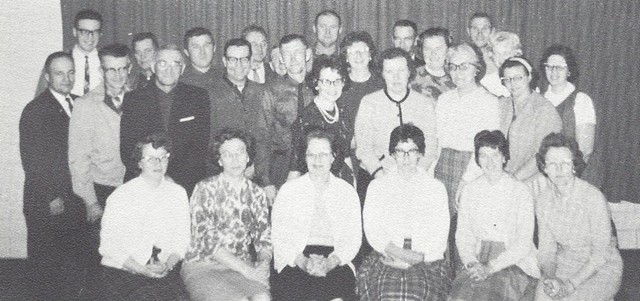
P. T. A. ORGANIZATION |
First Row: Left to right: Mrs. Hilbert Licht, Mrs. Alfred Holst, Mrs. Albert Schultz, Mrs. Marvin Clough, Mrs. William Hotz, Mrs. Werner Schultze.
Second Row: Left to right: Carl Hoyer, Martin Moench, John Schultz, William Hotz, Werner Bargsten, Mrs. Werner Bargsten, Mrs. John Schultz, Mrs. Karl Stahl, Mrs. Milton Licht, Mrs. Paul Meyer, Mrs. Ronald Udy, Mrs. Don Seltz, Mrs. Henry Froisland.
Third Row: Left to right: Ronald Udy, Donald Meyer, Hilbert Licht, Alfred Holst, Albert Schultze, Milton Licht, Pastor Brandt, Donald Seltz.
Page 22
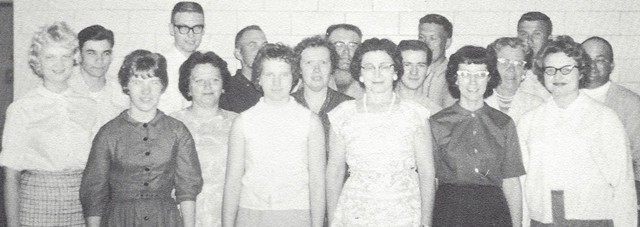
TRINITY LUTHERAN CHOIR |
First Row: Left to right: Mrs. Ronald Udy, Louise Stahl, Mrs. Edgar Licht, Cheryl Schulze, Mrs. Karl Stahl, Mrs. Arthur Jacobs, Morris Licht, Mrs. Herman Burger, Mrs. Herbert Gehring, Mrs. Roy Moench.
Second Row: Harley Hett, Ronald Udy, Marvin Clough, Wilbert Niemeyer, Vernon Niemeyer, Hilbert Licht, Roy Moench.
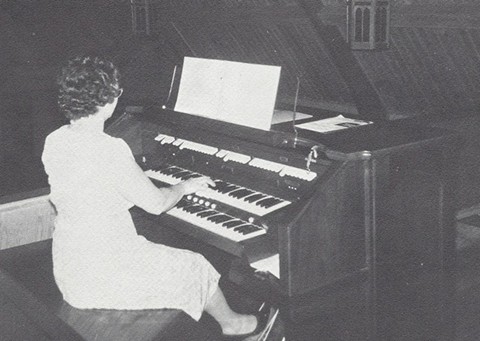
ORGANIST
Mrs. Arthur Jacobs
|
Page 23
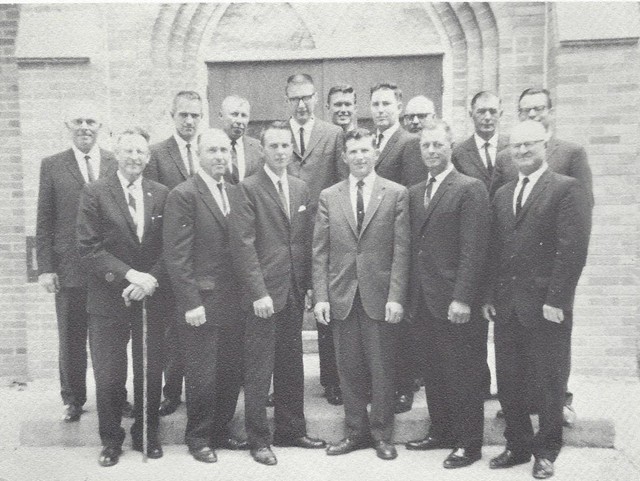 TRINITY LUTHERAN CHURCH COUNCIL TRINITY LUTHERAN CHURCH COUNCIL |
First row: Left to right: Arthur Jacobs, Herbert Gehring, Marvin Clough, Edgar Licht, Donald Meyer, Paul Meyer.
Second row: Left to right: Werner Schultze, Pastor Brandt, Robert Baker, Teacher Udy, Vernon Niemeyer, John Behrens, Harold Hett, Werner Bargsten, William Hotz.
Page 24
SOLI DEO GLORIA
It is solely to the Glory of God that these pages have been prepared, and the Diamond Jubilee of Trinity Congregation is observed. The anniversary committee: Ewald Schulze, Chairman; Walter Schulze, Alwin Behrens, Victor Niemeyer, Herbert Gehring, and Pastor Brandt, express their appreciation to the members and friends of the congregation, who provided materials and pictures for this book, the speakers, Reverend Arnold Boehnke, and Reverend Paul Weber, and to all others who have helped to make this observance possible.
“The Lord our God be with us, as He was with our fathers: Let Him not leave us, nor forsake us.”
I Kings 8:57 |